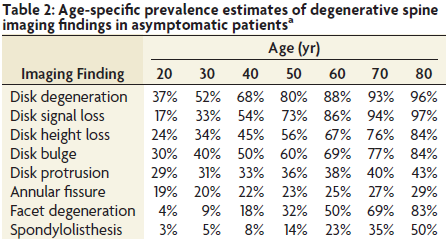WHAT’S THE MOST COMMON SOURCE OF NECK PAIN?
- In the Global Burden of Disease study; 291 different conditions were assessed for their contribution towards disability encountered by people over a lifetime. Neck pain in Australasia was ranked 3rd highest (out of the 291) in the overall disability it affects people’s lives and ranked 4th in the world.
- 80% of those with neck pain come under the category called ‘mechanical’ neck pain which simply means imaging scans show no sinister injury or pathology and there being no traumatic event (e.g. motor vehicle accident causing whiplash). Therefore mechanical neck pain is the most common source of neck pain.
- Mechanical neck pain refers to pain originating in the spine including;
- Discs: the discs in the neck (cervical spine) between each vertebra can be a source of neck pain (see picture below).
- Myofascial pain: symptoms originating from the muscles and their surrounding sheath called the ‘fascia’ which acts like a glad wrap around the muscles.
- Ligaments of the neck can also be a source of neck symptoms.
- Facet joints: these joints are commonly where arthritis; effectively ‘bony growth’ known as osteophytes develop. They are a common source of neck pain in those with a short-term ‘acute’ bout of symptoms (see picture below).
- IMPORTANT NOTE: Those without neck pain have been shown to have ‘degenerative’ changes on MRI scans of the neck (the cervical spine). Therefore, changes of our discs and facet joints naturally change with age and does not necessarily mean symptoms and disability will arise

5. The nerves passing near to the facet joints in the neck can refer pain around the neck, shoulder and mid-back region and therefore pain can be felt in different areas. See the picture below which shows the referral areas from the different levels of the cervical spine (see picture below).

6. A large study of 1211 healthy volunteers, aged 20-70, showed 87.6% had a disc bulge (whether considered minor or greater). The number of minor disc bulges as well the number of levels of the cervical spine where disc bulges were seen increased from 20 years of age and up (see table below with statistics). This strongly confirms that disc bulges and changes of the neck structures are seen in healthy, asymptomatic individuals and does not mean neck problems will eventuate.

7. Of all the non-surgical therapies for neck pain, exercise of the neck and shoulder girdle muscles has been shown in research studies to be the most effective treatment for mechanical neck pain.
| Hoy, D., March, L., Woolf, A., Blyth, F., Brooks, P., Smith, E., . . . Buchbinder, R. (2014). The global burden of neck pain: Estimates from the global burden of disease 2010 study. Annals of the Rheumatic Diseases, 73(7), 1309-1315.Jull, G., Moore, Ann, Falla, Deborah, Lewis, Jeremy, McCarthy, Chris, Sterling, Michele, & Khan, Karim. (2015). Grieve’s modern musculoskeletal physiotherapy (Fourth ed.). London: Elsevier Health Sciences UK.Cohen, S. (2015). Epidemiology, Diagnosis, and Treatment of Neck Pain. Mayo Clinic Proceedings, 90(2), 284-299.Brinjikji, W., Luetmer, P., Comstock, B., Bresnahan, B., Chen, L., Deyo, R., . . . Jarvik, J. (2015). Systematic literature review of imaging features of spinal degeneration in asymptomatic populations. AJNR. American Journal of Neuroradiology, 36(4), 811-816.Nakashima, H., Yukawa, Y., Suda, K., Yamagata, M., Ueta, T., & Kato, F. (2015). Abnormal Findings on Magnetic Resonance Images of the Cervical Spines in 1211 Asymptomatic Subjects. Spine, 40(6), 392-398.Gross, A. R., Goldsmith, C., Hoving, J. L., Haines, T., Peloso, P., Aker, P., … & Cervical Overview Group. (2007). Conservative management of mechanical neck disorders: a systematic review. The Journal of rheumatology, 34(5), 1083-1102. |


